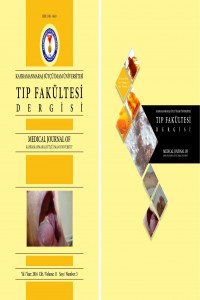Öz
ÖZET
Travmatik
asfiksi (Perthes sendromu); ciddi torasik kompresyon sonucu gelişen,
servikofasiyal siyanoz, peteşi ve subkonjonktival hemoraji triadı
ile karakterize bir klinik sendromdur.
Sunulan
olguda, torakoabdominal travma sonrası gelişen asfiksi sonucunda
oluşan klinik bulguların tanınması ve hastanın anestezi yönetimi
ile ilgili deneyimlerin paylaşılması amaçlanmıştır.
Trafik
kazası sonrası travmatik asfiksi saptanan, baş-boyun, göğüs
bölgelerinde siyanoz, ödem, peteşileri ve gözlerde
subkonjonktival hemorajisi olan 34 yaşında hasta tibia fraktürü
nedeniyle operasyona alındı. Servikofasiyal değişiklikler zor
entübasyon nedeni olabileceğinden videolaringoskopi
kullanıldığında, peritonsiller bölge ve hipofarinkste peteşi,
ödem olduğu görüldü.
Patofizyoloji
tam olarak açıklanamamakla birlikte, travma ile oluşan mediastinal
kompresyon sonucu artmış intratorasik basınç suçlanmaktadır.
Bulgular,
basının şiddeti, süresi ve hayati organ hasarlanmalarıyla
ilgilidir. Tedavi, mevcut patolojilerin tedavisi yanında destek
tedavisini kapsamaktadır.
Sonuç
olarak bu olgularda gerekebilecek cerrahiler nedeniyle anestezi
uygulamalarında uygun monitorizasyon yanında, entübasyon
zorluğunun değerlendirilerek gerekli ekipmanın hazır
bulundurulması önemlidir.
SUMMARY
Traumatic
asphyxia (Perthes syndrome); Is a clinical syndrome characterized by
cervicofacial cyanosis, petechiae, and subconjunctival hemorrhage
triad, with severe thoracic compression. When present, it is aimed to
identify the clinical findings that occur as a result of asphyxia
after thoracoabdominal trauma and to share experiences about the
anesthesia management of the patient.
A
34-year-old patient with traumatic asphyxia following trauma, with
cyanosis, edema, petitellar and subconjunctival haemorrhage in the
head and neck, thoracic regions, was excluded because of tibia
fracture. When videolaryngoscopy was used, the peritonsillary region
and the hypopharynx petechiae, edema were seen as cervicofacial
changes could be the cause of difficult intubation. Pathophysiology
is not fully explained, but increased intrathoracic pressure
resulting from trauma-induced mediastinal compression is implicated.
Findings are related to the severity of the press, the duration and
damage to vital organs. Treatment includes treatment of existing
pathologies as well as supportive treatment.
As
a result, it is important that surgeons who are needed in these cases
should be able to evaluate the difficulty of intubation and provide
necessary equipment in addition to appropriate monitoring in
anesthesia applications.
Anahtar Kelimeler
Kaynakça
- 1- Jobe J, Ghuysen A, Hartstein G, D’orio V. A fatal case of Perthes syndrome. J Emerg Trauma Shock 2013;6: 296-297.
- 2- Çelik B, Öztürk D, Gürz S. Travmatik asfiksi. J Exp Clin Med 2012;29: 163-165.
- 3- Kılıçgün A. Travmatik asfiksi. JClin Anal Med 2010;361.
- 4- Esme H, Solak O, Yurumez Y, Ermis S, Yaman M, Fidan F. Perthes syndrome associated with bilateral optic disc edema. Can J Ophthalmol 2006;41: 780-782.
- 5- Kamali S, Kesici S, Gunduz I, Kesici U. A case of traumatic aspyxia due to motorcycle accident. Case Rep Emerg Med 2013; Article ID 857131: 3 pages.
- 6- Ertok İ, Çelik Kurtoğlu G, Haydar Ercan G, Karakayalı O, Yılmaz M, Erşen T. Review of traumatic asphyxia syndrome with a case presentation. J Academic Emerg Med 2013;4: 58-61.
- 7- Imai M, Hanaoka Y, Kemmotsu O. Valve injury: a new complication of internal jugular vein cannulation. Anesth Analg 1994;78: 1041-1046.
- 8- Gulbahar G, Kaplan T, Gundogdu AG, Baran HN, Kazanci B, Kocer B et al. A rare and serious syndrome that requires attention in energency service: Traumatic asphyxia. Case Rep Emerg Med 2015; Article ID 859814: 4 pages.
- 9- Olusina DB, Nzegwu A, Ezike K, Ighakwe OU. Traumatic asphyxia as a predominant cause of accidental deaths in autopsies of 10 people who died in a stampede from a religious gathering in Enugu. Int J Natural Sci 2011;2: 443-446.
- 10- Eren B, Türkmen N, Fedakar R. An unusual case of thorax compression. J Ayub Med Abbottabad 2008;20: 134-135.
- 11- Choi YJ, Lee SJ, Kim HJ, Yim JH. Bilateral retrobulbar hemorrhage and visual loss following traumatic asphyxia. Korean J Ophthalmol 2010;24: 380-383.
- 12- Eken C, Yıgıt O. Traumatic asphyxia: a rare syndrome in trauma patients. Int J Emerg Med 2009;2: 255-256.
Öz
Kaynakça
- 1- Jobe J, Ghuysen A, Hartstein G, D’orio V. A fatal case of Perthes syndrome. J Emerg Trauma Shock 2013;6: 296-297.
- 2- Çelik B, Öztürk D, Gürz S. Travmatik asfiksi. J Exp Clin Med 2012;29: 163-165.
- 3- Kılıçgün A. Travmatik asfiksi. JClin Anal Med 2010;361.
- 4- Esme H, Solak O, Yurumez Y, Ermis S, Yaman M, Fidan F. Perthes syndrome associated with bilateral optic disc edema. Can J Ophthalmol 2006;41: 780-782.
- 5- Kamali S, Kesici S, Gunduz I, Kesici U. A case of traumatic aspyxia due to motorcycle accident. Case Rep Emerg Med 2013; Article ID 857131: 3 pages.
- 6- Ertok İ, Çelik Kurtoğlu G, Haydar Ercan G, Karakayalı O, Yılmaz M, Erşen T. Review of traumatic asphyxia syndrome with a case presentation. J Academic Emerg Med 2013;4: 58-61.
- 7- Imai M, Hanaoka Y, Kemmotsu O. Valve injury: a new complication of internal jugular vein cannulation. Anesth Analg 1994;78: 1041-1046.
- 8- Gulbahar G, Kaplan T, Gundogdu AG, Baran HN, Kazanci B, Kocer B et al. A rare and serious syndrome that requires attention in energency service: Traumatic asphyxia. Case Rep Emerg Med 2015; Article ID 859814: 4 pages.
- 9- Olusina DB, Nzegwu A, Ezike K, Ighakwe OU. Traumatic asphyxia as a predominant cause of accidental deaths in autopsies of 10 people who died in a stampede from a religious gathering in Enugu. Int J Natural Sci 2011;2: 443-446.
- 10- Eren B, Türkmen N, Fedakar R. An unusual case of thorax compression. J Ayub Med Abbottabad 2008;20: 134-135.
- 11- Choi YJ, Lee SJ, Kim HJ, Yim JH. Bilateral retrobulbar hemorrhage and visual loss following traumatic asphyxia. Korean J Ophthalmol 2010;24: 380-383.
- 12- Eken C, Yıgıt O. Traumatic asphyxia: a rare syndrome in trauma patients. Int J Emerg Med 2009;2: 255-256.
Ayrıntılar
| Konular | Sağlık Kurumları Yönetimi |
|---|---|
| Bölüm | Makaleler |
| Yazarlar | |
| Yayımlanma Tarihi | 24 Mart 2018 |
| Gönderilme Tarihi | 18 Ocak 2017 |
| Kabul Tarihi | 19 Şubat 2017 |
| Yayımlandığı Sayı | Yıl 2016 Cilt: 11 Sayı: 3 |


